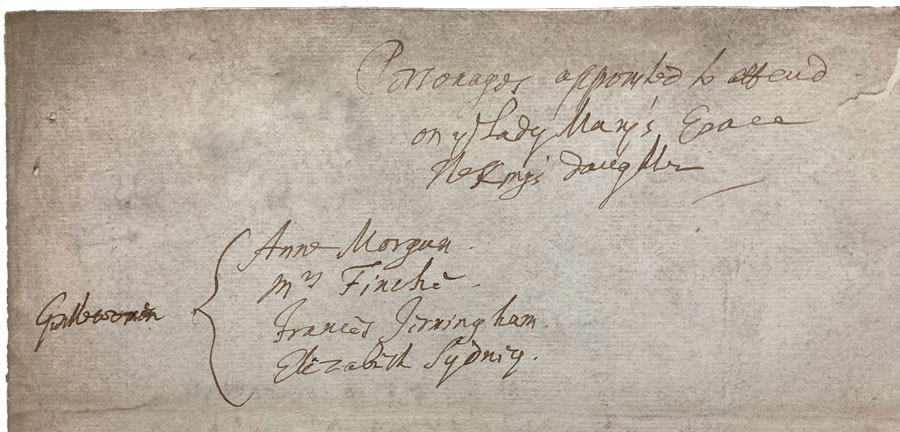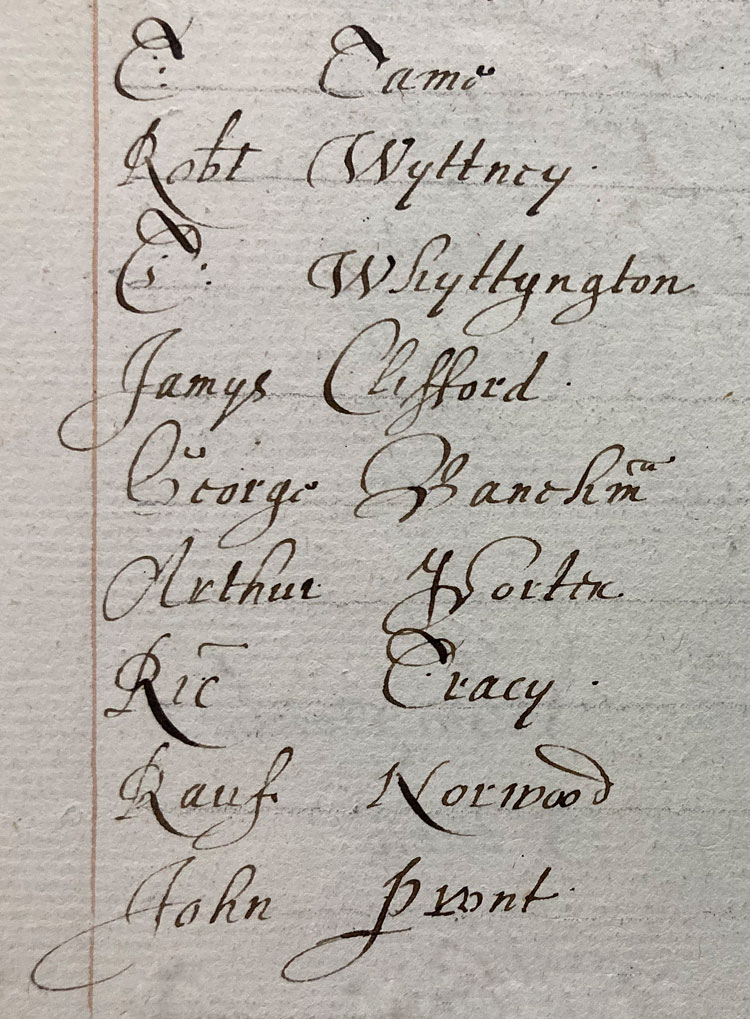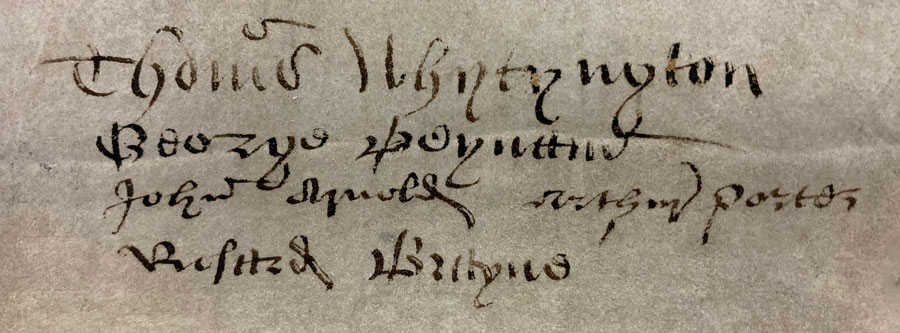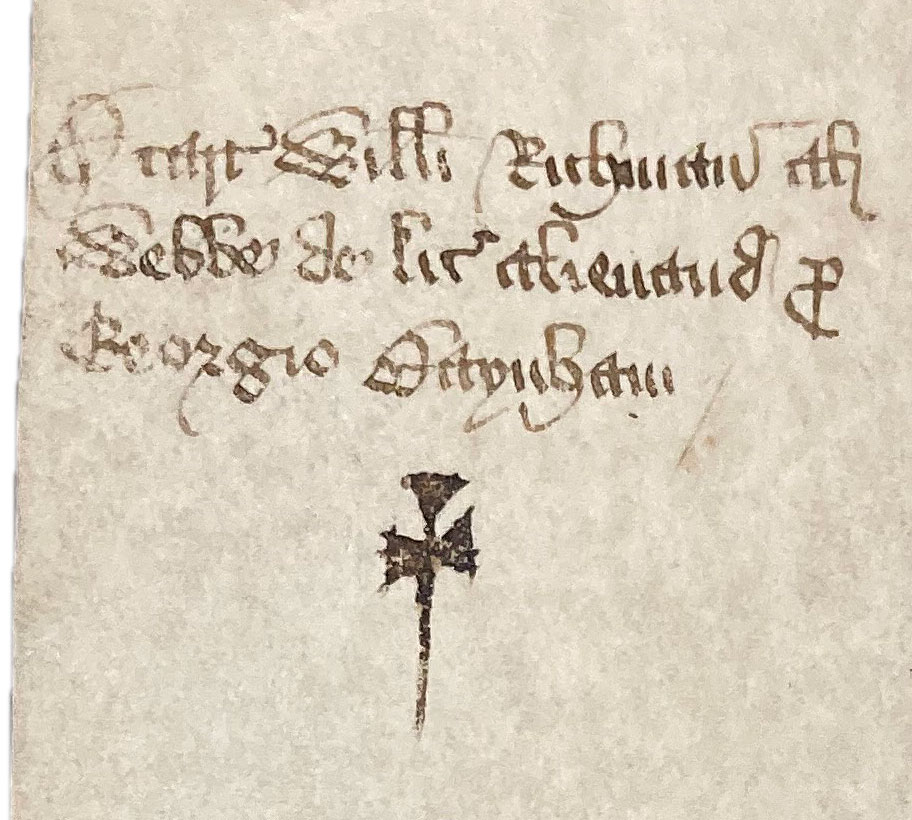Sir George Baynham (c.1500-1546)
Born: c.1500 at Clearwell
Parents: Sir Christopher Baynham and Jane Morgan
Married: c.1524 to Bridget Kingston and 1527 to Cecilia (Cecily) Gage
Died: 1546 at Clearwell
George was born at Clearwell, Gloucestershire around 1500.
He married Bridget Kingston daughter of Sir William Kingston and Mary Jerningham (who, as Mary Scope, had previously married Edward Jerningham) at Newland in 1524, when he was around 24 she was 21. They had one child, Frances in c.1526. Bridget died in 1526.
He then married Cecily Gage, daughter of Sir John Gage and Phillippa Guildford at West Firles, Sussex in 1527, when he was around 27 and she was around 19. They had twelve children – five sons and seven daughters. Cecily died at Clearwell in 1585.
George died at Clearwell in 1546, aged about 46.
George was given Clearwell Court by his father during Sir Christopher’s lifetime.
George’s first marriage was to Bridget Kingston, daughter of Sir William Kingston KG of Flaxley (d.1554) and Mary Jerningham at Newland in 1524. Bridget died in 1526, possibly in childbirth.
Their daughter Frances was born in 1526. As a young girl, in 1536 she married Sir Henry Jerningham (1512-1572), son of Sir Edward Jerningham (d.1615) and Mary Scrope (d.1548).
Henry was admitted to the Inner Temple in 1528 and was Constable of Gloucester Castle from then until his death in 1572. He was a Catholic and always a close supporter of Mary Tudor; Frances Jerningham became one of Lady Mary’s gentlewomen in 1536.

Around 1540, Henry and Frances brought a case against George and Sir Christopher’s widow Jane concerning money due to Frances under the marriage settlement of her mother Bridget Kingston.

Mary appointed Henry Vice-Chamberlain of the Household, Captain of the Yeomen of the Guard and a Member of the Privy Council when she became Queen in 1553.
Frances became one of Queen Mary’s Ladies-In-Waiting and was in attendance at her wedding to King Phillip II of Spain the following year. It is recorded that the Ladies wore gowns of purple velvet.

In 1577, Lady Frances Jerningham’s name appeared on a list of Norfolk recusants (she kept a priest, Mr. Dereham, who had once been her son’s schoolmaster). The following year, during her Progress, Queen Elizabeth I dined with Frances at Costessey Hall, the home near Kings Lynn which had been a gift to Henry Jerningham from Queen Mary; despite being known as a Catholic, Frances was not prosecuted for her faith.
[ she later appears in a number of documents: lease of house at Blackfriars, etc ]
Frances died at Costessey in 1583 and was buried there on 23 December. Her will was proved on 15th February 1584.
After Bridget’s death, George married Cecily Gage, daughter of Sir John Gage of Highmeadow (1479-1556) and Phillippa Guildford at West Firles, Sussex on 15th November 1527. [ link to Cecily’s Gage pedigree ]. With her, he had twelve more children – five sons:
1. Christopher, who was born around 1528 and was still a minor at the time of his father’s death in 1546; as heir, he was made a ward of the Crown. He was educated at Lincoln’s Inn where he was admitted on 4th March 1547, his admission supported by Roger Rokeby III …. [ add extra info re tenure ] …….. He came of age in 1549 and inherited Clearwell Court. He married Bridget Porter, daughter of Arthur Porter and Alice Arnold around 1552, but had no children. He paid a fine to avoid a knighthood in 1554/5. He was appointed Sheriff of Gloucestershire in ….. He died on 6th October 1557 and was buried at Newland. After his death, the estate passed in turn to his brothers Richard (d. 1580) and then Thomas (d. 1611). An inquisition post mortem was held in 1558 [ Christopher Bayneham, Gloucester NA C 142/113/49, 4 & 5 Ph & M ]. His widow Bridget is said to have died at Calais, France in 1558.
2. Richard, who was born around 1530. He inherited Clearwell Court from his elder brother when Christopher died in 1557. He served as High Sheriff of Gloucestershire, 1570-71. He also sat in the Court of High Commission set up by Elizabeth I in 1574 [ see The Gloucestershire Gentry by Joan Johnson p. 49 ]. He was unmarried and had no children. Richard died in 1580.
3. Thomas, who was born in 1536. He married Mary Winter, daughter of Admiral Sir William Winter (c.1521-89) of Lydney, Gloucestershire in 1578 at Lydney. He inherited Clearwell Court in turn from his elder brother when Richard died in 1580. He was knighted in …….. He was High Sheriff of Gloucestershire 1582-83 and 1602-03. With Mary, Thomas had four children – (i) Thomas (1581-c.1604), baptised at Newland on 6th September 1581; he was unmarried and had no children (ii) Cecily (c.1583-1614) who married Sir William Throckmorton (1579-1628) Ist Baron of Tortworth and Deputy Constable of the Forest of Dean, son of Sir Thomas Throckmorton and and Elizabeth Berkeley. She produced several children, including Sir Baynham Throckmorton, 2nd Baron of Tortworth MP (1606-1664), Elizabeth Throckmorton (1608-75) who died unmarried and was buried at Newland on 15th December 1675 (her will was proved at Gloucester in 1676) and Sir Nicholas Throckmorton (d. 1664) whose son Sir William Throckmorton (d. 1682) was the 4th and last Baron. Cecily inherited the Clearwell and Newland estates from her father in 1611. She died in 1614 and was buried at Tortworth on 20th November. Sir William, her husband, is recorded as having ‘wasted his estate by riot and improvidence’, but later married Alice Morgan, and then Sarah Hall. He died on 18th July 1628 and was buried at Newland on 20th (iii) Joan (1585-1647), baptised at Newland on 17th November 1585; married John Vaughan (d. 1618) of Kinnersley in Herefordshire and produced four children. As co-heiress of her father’s estate, she inherited land at Mitcheldean and Abenhall and retired there when her husband died. She was imprisoned for her Catholicism in 1641, at Gloucester. She died in 1647 and was buried at Abenhall on 7th June (iv) George Baynham (1586-c.1606), baptised at Newland on 23rd October 1586; he was unmarried and had no children. He died before his father and was possibly the ‘George Baynham’ buried at St. Saviour’s church in Southwark on 1st August 1606. Thomas died on 2nd October 1611 and was buried at Newland; his property was divided between his daughters – his will was proved in the PCC on 21st June 1612, and an Inquisition Post Mortem was held in 1613.
4. John, who was still living in 1546 when his father died (he was mentioned in his will), but died unmarried and without children.
5. George, who was still living in 1585 when his mother died (he was mentioned in her will), but died unmarried and without children.
and seven daughters –
1. Dorothy, who married Roger Williams (d. 1585) of Usk and Llangibby in Monmouthshire; she was still living in 1611, when she was mentioned in her brother’s will.
2. Mary, who married a Fenton
3. Jane, who married a Tuberfield.
4. Joan, who married Sir Anthony Strelley (1528-1591) of Strelley in Nottinghamshire, son of Sir Nicholas Strelley (d.1560) and Isabel Spencer; Joan was still alive in 1585.
5. Anne, who married Sir Anthony’s brother John Strelley (b.1532) in around 1553.
6. Phillippa, who married William Connock (or Connox) of Coleford in Gloucestershire (d. 1623), but had no children. She died in about 1636; her will was proved on 6th February 1637.
7. Alice, who married Thomas Brayne of Littledean, Gloucestershire (d.1604) on 27th May 1573 at Newland and died before him.
The first mention of George in official records appears to have been in 1522, when the King ordered a military survey of England, by county (the survey of Gloucestershire is one of the few to have survived). It was intended to record personal wealth in land and goods, items of military equipment such as suits of armour and weapons) and whether a man was fit for combat.
While his father Christopher and his step-uncle Sir Alexander appeared with a land value or as steward several times, young George (now just 22 years old), appeared only once: for Mitcheldean and Abenhall he appeared as “George Beynam esq lord of Abenhall and is worth £15”, below Alexander who is “lord of Mitcheldean and worth £20”. There were listed a further 102 men of varying worth who possessed their own combinations of harness and almain rivets (types of armour), hauberks (shirts of chain mail), bows & arrows, swords & shields, daggers, lances, bills and other weapons, plus a few horses.
Unlike Alexander and Christopher, there was no goods value recorded for George so it is not possible to say from the survey where he was living at the time (Alexander was living at Westbury-on-Severn and Christopher at Clearwell).
Like his father, George was not recorded as being in possession of any armour or weapons himself.
On 10th February 1528, Sir William Kingston, Knight of the Body, and George Baynham Esquire, who is described as ‘unus appositorum Regis, ad mensam’, were given a grant in survivorship of the office of constable of the castle of St Briavel, in Dene forest, Gloucestershire, with the usual fees payable out of the issues of the said forest and of the lordship of Newland.


From 1532 there is a letter sent by George to Thomas Cromwell in which he said that he (‘your servant, this bearer’) has taken pains that the Abbot of Tewkesbury will let the farm of Stanwey to Cromwell and his assigns. He urged Cromwell to move for the manor and lands as well as the farm, ‘otherwise it will be no meet place for the writer to inhabit’. He adds that the Abbot has two or three manors besides, which are more convenient for him. He begged Cromwell to press this with speed.


At the time of the Northern Rebellion or Pilgrimage of Grace in 1536, George and his father Sir Christopher were mentioned in the king’s plans to put down the uprising; they were included in lists of gentlemen in the southern and midland counties to whom it was proposed to write letters – overnight watches were to be kept in every shire, beacons were to be prepared in every port and watches kept there too and posts were to be set up by special commandment. George was also required to provide 150 men for the Gloucestershire contingent.


On 1st March 1538 a grant was made to George Baynham, as Esquire of the Royal Body, to be bailiff of the lordship of Lydney and keeper of the woods in Dean Forest.


Also in 1538 George and his father Sir Christopher appeared as defendants in two cases in the Court of Star Chamber (the Supreme Court of the day):
the first was brought by John ap Gwellym, Sewer of the King’s Chamber, regarding an assault in the house of John Wynter at Lydney, Gloucestershire
and the second (related?) case brought by John Wynter himself regarding forcible entry there.


In the Spring of 1539 musters of able men were taken by county.
For Gloucestershire, the Certifcate was given by his father Sir Christopher, George and three others “of the muster of armour, weapons and able men, by virtue of the King’s commission to them and othes, taken for the hundreds of Botlowe, Weysbury, Briavelles, Bledislow, and the duchy of Lancaster, in co. Glouce., according to the division among all the commissioners made 31st March 1539.”

For each place (starting with Dymmock), the roll listed men with horse and harness, their various weapons and in the margin a letter ‘a’ denoting those who were ‘able’.

In the same year plans were drawn up for the reception of Anne of Cleves and covered the journey from Calais to London, prior to her first choreographed meeting with Henry. George appeared in the list of esquires in a ‘Book of Certain Names’ of those appointed to receive her.


Additional plans from 1540 show another list of esquires, similar but not the same as the list produced the year before, but still including George.


The additional plans from 1540 show a detailed itinerary to bring Anne from Dusseldorf to Calais.

They also included ‘An order taken how the King’s Highness shall ride at the meeting of the Lady Anne Grace of Cleves, etc’.

On 10th May 1540 George purchased a 21-year lease of the manors of Raddell in Gloucestershire and Hopemelsham in Herefordshire from the Court of Augmentation, which had been set up to dispose of the properties which had become Crown lands after the dissolution of the monasteries; these manors had formerly been held by St. Peter’s, Gloucester.

The is the only time George is referred to as ‘George Baynham of Westbury’. So where was he living now ..?

The account of Sir Richard Paulet, Receiver of the Court of Augmentations for the counties of Hampshire, Wiltshire and Gloucestershire and the town of Bristol was produced for the year ending Michaelmas 32 Henry VIII.

It ‘detailed minutely the items of receipt and expenditure’ …
… including, under the heading of the Monastery of Tewkesbury, particulars of the lease to George.

Less than a month later, on 1st June 1540, George was granted another 21-year lease – of the manor of Walshebekenor [Welsh Bicknor] in the Marches of Wales. This property had belonged to Margaret Pole, Countess of Salisbury, who had been attainted in the previous year and lost her title and all her lands.

In this lease he is simply ‘George Baynham esquire’.

George’s father Christopher died on 22nd June 1540.
On 18th September 1540 George was appointed to a Commission of the Peace and of Oyer and Terminer for Gloucestershire.

In May 1541 George received [de-]livery of those lands and possessions of his deceased father Christopher to which he was entitled.



In September 1542 Justices of the Peace were again required to take musters in their county.
In Gloucestershire the commissioners divided the hundreds among themselves: “How the justices of the peace within the said county divided themselves into sundry hundreds of the same county for the execution of the King’s Highness commission for muster to them directed”.

Thomas Whittington, George Baynham, John Arnold, Arthur Porter, Richard Brayne and Thomas Havard took the Hundreds of Westbury, Botlowe, Seynt Brevelles, Bleddeslowe and the Duchy of Lancaster.

The roll recorded that George Baynham and Richard Brayne worked their way through the Hundreds of ‘Seynt Brevelles’ and ‘Bledyslowe’:

“Hereafter ensueth the names surnames and dwelling places of all ———- and are appointed in a ———- to have harness and other weapons and also the names of all able archers and billmen within every tithing, township and borough inhabiting and living in the hundreds of Sente Brevelles and Bledyslowe mustered viewed and tried by George Baynham esquire and Ric[hard] Brayn, two of the commissioners by our ——–Lorde the King ———– assigned ——— and to the —— hundreds ————- allotted and appointed”.
The list of places started with ‘The townshyppe of Mycheldeane’.
For each place (township, village, parish, hamlet, etc.) the roll listed the names of the men, and some women, with the armour and weapons they had (eg. horse harness for two men, bill and a body harness, bill, bow and a number of arrows) and in the margin the term “byll” or “ar” was used to denote an able billman or archer.
In the Hundred of St. Briavels, George appeared on the roll of 52 men for ‘Clowrwalles Bem’ with harness for 4 archers on horseback and 6 billmen afoot; this shows that George was living at Clearwell Court at the time of the muster.

The muster roll comprised 28 membranes, divided into five sections each of which was signed by Thomas Whityngton, George Beynam, John Arnold, Arthure Porter and Richard Brayne.


On 8th March 1543 George was appointed to his first Commission of Sewers for Gloucestershire.


On 28th June 1543 George, as executor of John Walshe, was granted an annuity of 11l. 12s. out of Loddington manor and lands in Stratford, Parva Hall and Shelford in Warwickshire during the minority of John’s son and heir Francis, over whom George had wardship and right of marriage.
Like his father and grandfather before him, George was also Sheriff of Gloucestershire, in 1544 –

this version of the Sheriff Roll, published in 1546, recorded the names of the three candidates for the office in 1544, but there is no ‘pricked’ roll surviving to show that George was selected as Sheriff.
Also like them, George was a Justice of the Peace on several occasions [ inc 1537 & 1542 ].
George’s mother Jane died in 1544.
Another Muster Book was produced at the end of March 1544 in preparation for the War against France.
It included George Baynham twice: first, in the list of members of the King’s Council as the son of Sir John Gage, the Comptroller of the Household; however, this entry was deleted, presumably because George was not the son, but the son-in-law of Sir John who was required to provide 21 horsemen and 300 footmen.

secondly, George was included in the list for Gloucestershire where he appeared as both Baynham and Beynham alongside several of his relatives and local acquaintances.

In July of 1544 he went to France as part of the 39,000-strong army raised by the king.
The force landed in Calais and subsequently laid siege to Boulogne, which fell on 14th September 1544; Henry entered the town in procession on 18th.

George was knighted by King Henry VIII at Boulogne on 30th September.

1546 – January … another muster …. with list of comissioners for each county …
In February 1546 a licence to alienate was granted to William Richman alias Webbe.

It permitted the transfer to George of various properties in the manor of Overwroughton.

George died at Clearwell in 1546 [ on 25th September ? ] and was buried at Newland, in All Saints’ church, like his father Sir Christopher.
He left a will dated 9th June 1546 which was proved on [ 4th December 1548 ? ].
An Inquisition Post Mortem was held in Wiltshire [ on 25th September 1546 ? ] [ NA C142/75/92 ].
Sometime in September 1546, presumably just after George had died, an Abridgement of Bills which the king caused to be stamped at various places during that month included at number 67 “the constableship of a castle withn the forest of Deane, with the keeping of the woods there and the bailiwick of the lordship and manor of Lydney in Goucestershire, which offices George Baynham had, for Sir William Herbert and Richard Breame, esquire, jointly and severally, during their lives”.

Cecily survived him and later married Sir Charles Herbert MP (d. c.1557) of Troy in Monmouthshire.
She died in [ June or July ? ] 1585 and her will was proved in the PCC on 8th July 1585.
Notes:
Mary Scrope first married Sir Edward Jerningham in c. 1509 and produced a son Henry Jerningham, who would later marry Frances Baynham.
As Mary Jerningham, she married Sir William Kingston (before 1534) and produced a daughter Bridget Kingston, who would later marry Sir George Baynham and produce a daughter Frances Baynham ..!
Elizabeth Jerningham was the younger sister of Sir Henry Jerningham, husband of Frances Baynham. She was a Maid of Honour to Queen Mary, as her mother had been – first as Lady Jerningham and then as Lady Kingston, Mary had been in the Queen’s household since c.1490.
George Baynham was granted wardship and right of marriage of Francis Walsh (b.1534), the son and heir of John Walshe and George’s sister Alice. Francis married Anne Cornwall, daughter of Jane Wogan and Richard Cornwall, 9th Baron of Burford in Shropshire.
Buried on 18th January 1604, in Bristol?
Cecily was apparently married to Sir William Throckmorton on 24 September 1602 ‘in an out malt room in the house of Thomas Bayneham in Newland by John Carelesse’, curate of Morton Jeffries in Herefordshire …. [ what happended next? ]
Sir William Throckmorton was killed in a duel in 1682, so the Tortworth baronetcy became extinct. He was buried at Hewelsfield [ in 1684 ? ]
Acknowledgements:
- 1528 Constable – National Archives,
- 1532 Letter to Cromwell – National Archives,
- 1538 Northern Rebellion x2 – National Archives,
- 1538 Bailiff and Squire for the Body – National Archives,
- 1538 ap Gwellym – National Archives,
- 1538 Wynter – National Archives,
- 1539 Plan for reception of Anne of Cleves – National Archives,
- 1540 Reception of Anne of Cleves – National Archives,
- 1540 Commissioner of the Peace – National Archives,
- 1540 Court of Augmentation – National Archives,
- 1540 Lease of Welsh Bicknor – National Archives,
- 1540 Augmentation accounts – National Archives,
- 1540 JP – National Archives,
- 1540 OT – National Archives,
- 1541 Livery of C lands – National Archives,
- 1542 Muster, preamble – National Archives,
- 1542 Muster lists – National Archives,
- 1543 Appointment of George Baynham to Commission of Sewers – National Archives, C 66/720, m. 9d
- 1544 Appointment of George Baynham as Sheriff of Gloucestershire – National Archives, C 227, Roll 1b
- 1544 George Baynham included (twice) in Muster Book for the Army against France – National Archives, SP 1/184, f. 222
- 1544 Arms of Sir George Baynham
- 1545 Murder of Servant – National Archives,
- 1546 George Baynham referred to in Licence to Alienate granted to William Richman – National Archives, C 66/777, m. 5
- 1546 George Baynham recorded posthumously as former holder of Constableship of St. Briavels – National Archives, SP 4/1, no. 67
- Wedding of Queen Mary Tudor to King Phillip of Spain
- Siege of Boulogne
